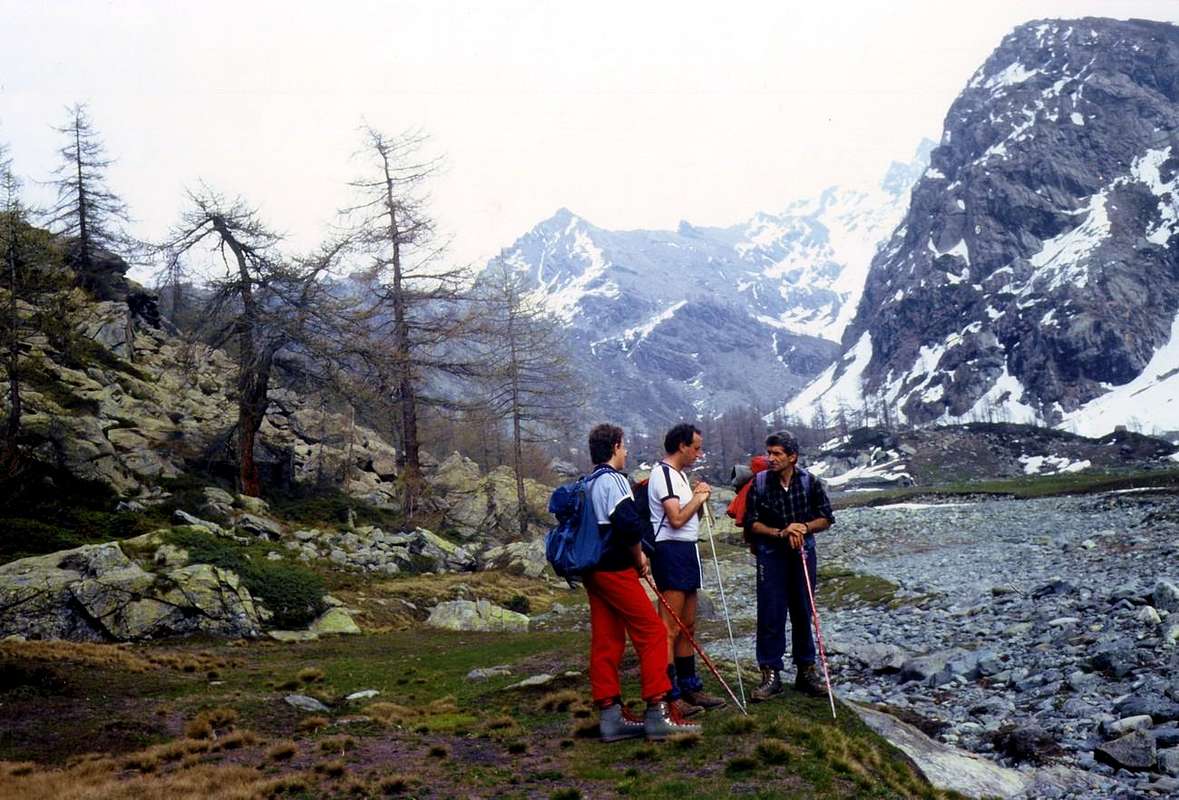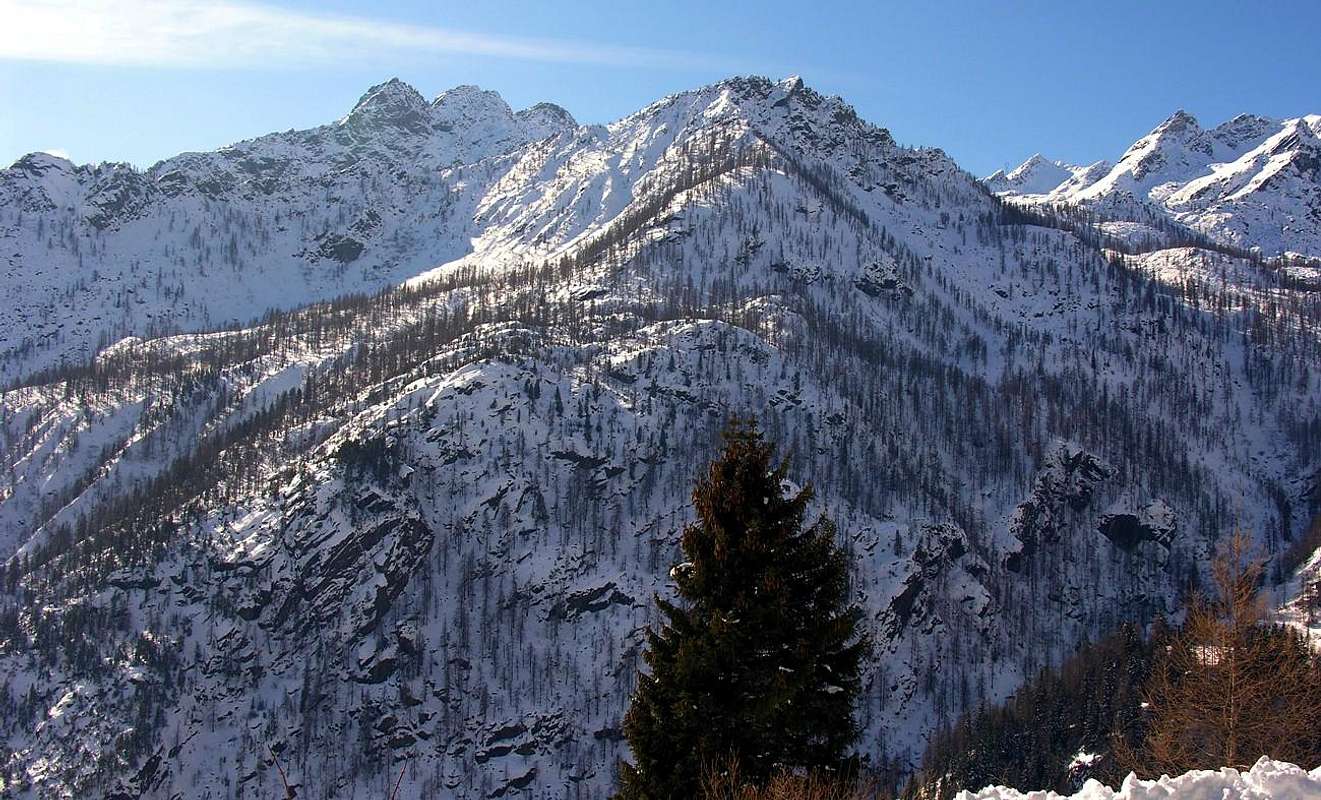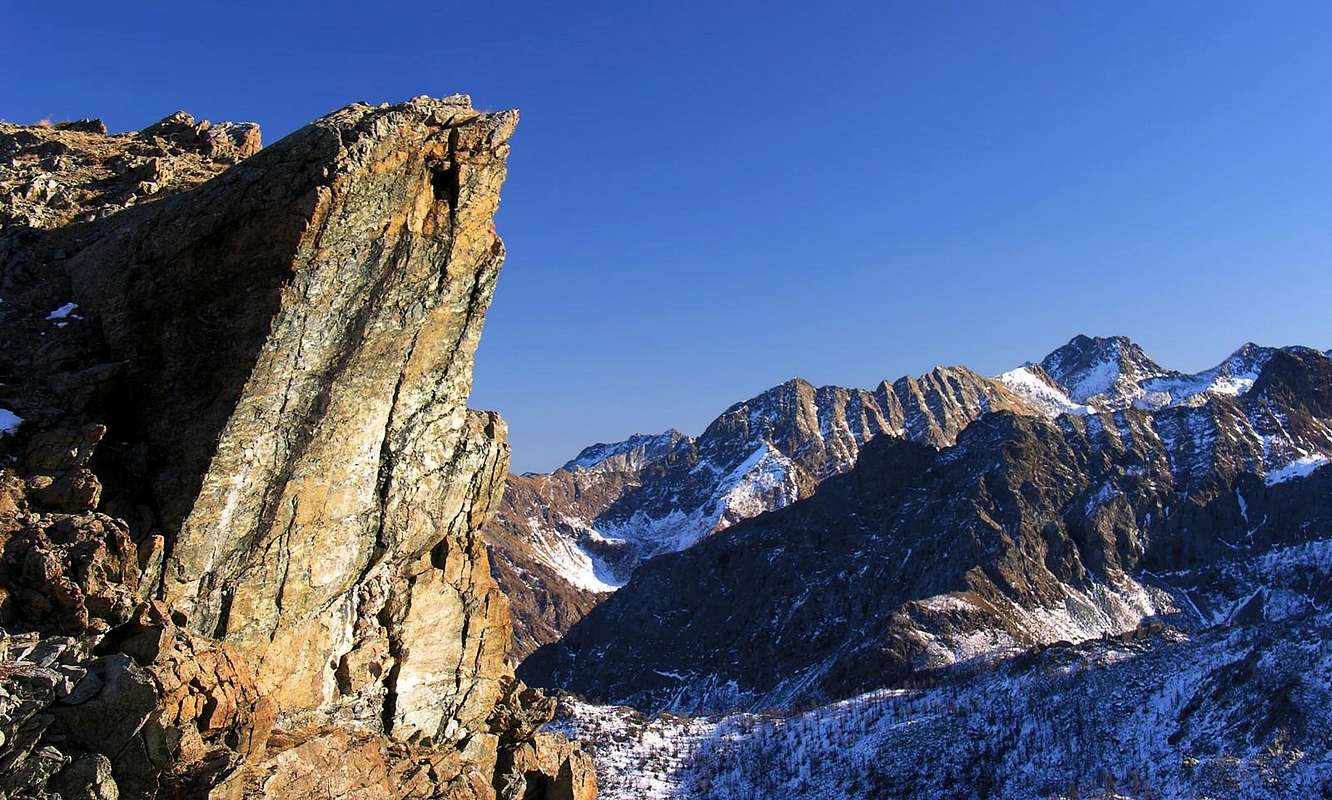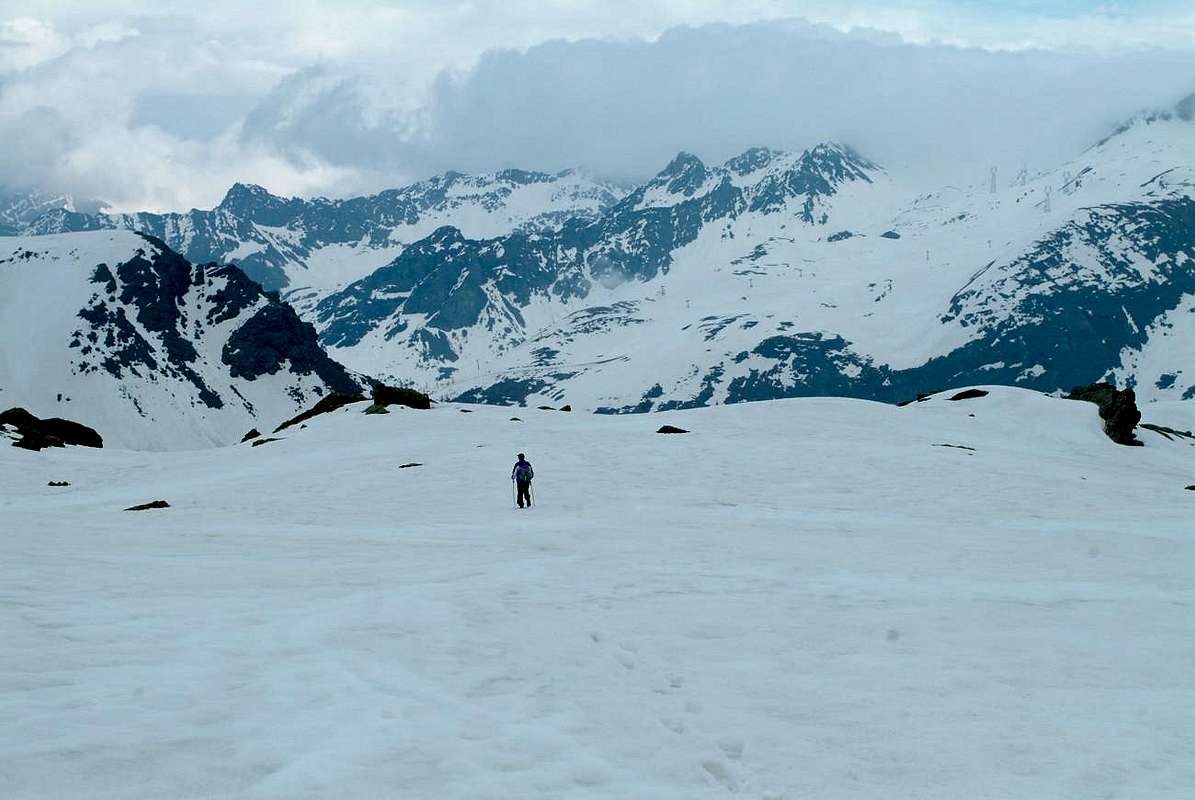-
 2897 Hits
2897 Hits
-
 80.49% Score
80.49% Score
-
 12 Votes
12 Votes
|
|
Mountain/Rock |
|---|---|
|
|
45.59250°N / 7.60257°E |
|
|
Mountaineering |
|
|
Summer, Fall |
|
|
8379 ft / 2554 m |
|
|
Note
|
La montagna chiama i suoi figli, ed essi rispondono fedelmente al suo appello… Osvaldo Cardellina, Diario alpinistico, 1964-65 Page texts: @ OsvaldoCardellina "Osva", passed away on May 2, 2022. Page owners: Christian Cardellina e Osvaldo Cardellina. Any updates from September 12, 2022: Antonio Giani, page administrator, friend and climbing companion. Testi della pagina: @ OsvaldoCardellina "Osva", scomparso il 2 maggio 2022. Proprietari pagina: Christian Cardellina e Osvaldo Cardellina. Eventuali aggiornamenti dal 12 settembre 2022: Antonio Giani, amministratore della pagina, amico e compagno di salite. |
Wood Overview Valley

Questa Sommità fà parte del Gruppo del Monte Marzo (2.756 m), posto tra le Valli di Champorcher e Pianprato Soana e Chiusella in Piemonte. In realtà il gruppo di appartenenza risulta, anche se meno conosciuto, quello del Monte Nero (2.737 m), essendo questa la Sommità la più elevata in questo tratto di spartiacque con la Valle di Aosta e subito ad Occidente del precedente vallone. Da questo ultimo scende verso Settentrione un contrafforte secondario, atto a separare il Vallone della Legna ad Est da quello di Vercoche ad Occidente. La testata centrale di questo vallone, raggiunto il Monte Marzo (2.756 m), il Monte Facciabella (2.654 m) ed il sottostante Colle di Santanel (2.464 m), si sdoppia tra il Monte Nero (2.737 m) ed il Monte Santanel (2.721 m). Volendo però in modo completo analizzare topograficamente questo vallone risulta necessario partire dal Monte dei Corni (2.778 m). Dopo il Colle della Fricolla (2.542 m) (*** collegamento tra i due nella loro parte più elevata tramite il Col Bruillet (2.450 m), ma in realtà si divide dal successivo Vallone di Brenve) la cresta si rialza all'omonima Punta (2.676 m), sopra il Lago Cornuto (2.450 m); quindi la cresta prosegue, sinuosa, formando la Cresta di Chenessy (2.756 m) che "seghettata" forma una serie di almeno quattro elevazioni (2.616 m, 2.665 m, 2.650 m, 2.616 m) prima di raggiungere la Punta di Chenessy (2.630 m). Questa, chiamata in B&V 1896, pagina 26 Costa di Canessi con quota 2.631 metri, anche se di poco meno alta si distingue maggiormente poiché isolata. Ai suoi piedi ad Est si trova il laghetto omonimo (2.383 m), mentre sull'opposto versante scende con dirupi roccioso-erbosi al di sopra dell'Alpe Chenessy (2.051 m) nel Vallone attiguo della Legna. Una cresta rivolta a Nord-nordest continua ripida verso i Colli della Manda (2.390 metri circa m) e Detrà (2.350 metri circa), separati da una piccola Sommità 2.414 metri. Oltre lo spartiacque continua più a Nordest formando il tondeggiante Mont Giavin (2.431 m), il Col de Creuset (2.121 m) per terminare con il Mont Digny (2.145 m) sopra la Cresta di Lutta ed i piccoli Villaggi di Frassiney e Trambesere, ormai sul fondo valle. Sono montagne poco conosciute ed ancora di meno frequentate, se non dagli abitanti locali o da qualche amatore delle cose rare, come dimostra il misero tumulo trovato sulla Sommità dell'adiacente Punta di Chenessy, anche se per la verità "Guida delle Alpi Occidentali", identica pagina, segnala: "... punto culminante (segnale trigonometrico) della catena divisoria tra i valloni della Legna e della Amanda ..."; segno che oltre 100 anni prima era già abbastanza popolare. Almeno dai Topografi dello Stato Piemontese-Sardo, ma anche a dimostrazione che "Re Toio" era geloso dei possedimenti controllandoli meglio di come fan oggigiorno. Facendo però un passo indietro dobbiamo ritornare al Mont Santanel dal quale parte verso Nordest una cresta intermedia tra quella di Chenessy (Est) e la successiva che dal Colle Larìs raggiunge l'omonimo Bec, dopo aver scavalcato il Bec Molère (2.638 m). Questo spartiacque propone un contrafforte che, flettendo a Nordest, si esaurisce sopra l'Alpe di Ourty (1.527 m) dove la valle si sdoppia inviando verso Meridione il Vallone della Legna ed a Sudovest quello dei Laghi Vercoche, Piana e Molère. Il medesimo é formato da una cresta rocciosa, apparentemente piuttosto ostica allo sguardo, che scende con Punta, Colletto, Cresta e Torre di Vorèa (2.544 m, 2.450 m, 2.442 m) fino sull'alpeggio citato. Comunque rimangono valloni più frequentati dai Pescatori che dagli Alpinisti od Escursionisti, anche e forse soprattutto a causa dei lunghi ed estenuanti avvicinamenti. Questa vasta area, distendentesi ad Oriente verso il Canavese ed Ivrea ed a Sudest verso la Pianura Padana e la Città di Torino, costituisce le propaggini estreme del Gran Paradiso dopo le ultime importanti Sommità della Torre di Lavina e della Rosa dei Banchi, per la qual cosa appartiene ancora alla Catena montuosa delle Alpi Graie che da qui risale fino a quella del Monte Bianco. Da questa si godono piacevoli vedute sul circondario a partire dal Monte Marzo, ma anche su quella serie di piccole Cime semi abbandonate che si allungano verso la Bassa Valle. Frontalmente invece, approfittando della catena che dal Mont Glacier (3.186 m) digrada sempre più verso Est-nordest "aprendo" la vista, si posson ammirare le Valli del Marmore, Lys e Gressoney fino a lor termine, cioé al Cervino ed all'estesa Catena del Rosa dai Breithorns, Lyskamms, Zumstein, Dufour, Gnifetti ed al divisorio col Piemonte.

First Ascents
- First on the Summit: unknown.
- In winter: unknown.
- North-northeast Ridge (from Vorèa Tower): Roberto Nicco and Company; May 1987?, in ascent from Vercoche Vallon.
- East-northeast Ridge (North Side of the crest): Christian Cardellina (14 years old), Camillo Roberto Ferronato and Franco Lucianaz; May 24th, 1987, in ascent from Outre l'eve Hamlet, Ourty Alp, St. Antonio-Case Vecchie in Legna's Vallon.
- East-northeast Ridge (in edge with traverse to Western Summit): Osvaldo Cardellina, lone; May 24th, 1987, in ascent from St. Antonio-Case Nuove.
- Southwest Ridge (Integral): Osvaldo Cardellina, Christian Cardellina, Camillo Roberto Ferronato and Franco Lucianaz; May 24th, 1987, in descent to Alpe Peroisa.
Getting There
BY CAR:
- From TORINO, MILANO, etc: Motorway A5. Exit at IVREA or Quincinetto (PIEDMONT).
- From IVREA Town: Pont Saint Martin, Donnas, Hône, Bard, Pont Bozet, Champorcher Municipalities. From Hône Commune (364m), crossing the bridge above Dora Baltea, to Bard Municipality (566m; renowned Austrian Fortress) and through Regional Road towards Pont Bozet (775m) with the asphalt road to Champorcher Valley, up to the Outre l'Eve Hamlet (1.229m) and until the Alp of Ourty (1.344m) at the beginning of Legna Vercoche Vallons. After by meletrack or various paths. Also starting directly from Pont Bozet-Foliettaz/Delivret Villages (about 850/900 meters) with path in Southwest in Manda or Amanda Vallon to the la Manda Alps (2.003m), near Chenessy (2.383m) and Cornuto (2.450m) Lakes, the slopes of the Eastern Punta Chenessy.
- From FRANCE: through the Mont Blanc Tunnel to Entrèves-crossroads to Vény/Ferret Valleys nearby Courmayeur Resort. By Little Saint Bernard Pass, closed since November until half May to La Thuile Valley - Pré Saint Didier - Courmayeur. It is not necessary to take Motorway A5: you can drive on SS.26, in the direction of AOSTA - IVREA - TURIN.
BY PLANE:
- Aeroporto "Corrado Gex" Saint Christophe (Aosta).
Approaches & Routes
Approach A: from Outre l'Eve Hamlet through Legna's Vallon and Southwestern Crest From Outre l'Eve (1.207/29m) take the trail n° 4 just West of the small village and go with Southeast direction to the Chapel of Cret (1.344m), where the same is directed more to the South. Immediately after reaching the junction at the Pian Bouch Pasture (1.354m) and, leaving the left (East) path n° 3C leading to Mont Digny, continuing instead to Southwest coming to Alp of Ourty (1.344m), under the Vorèa Buttress where the trail splits. Leaving right branching in the Southwest that, through the path n° 4F, reach Lake Vercoche, continue to Southeast with the opposite entering the "true" Legna's Vallon. Turning next to the left of Legna Torrent (coming down from the Lakes Chiletto and Giorso) bank orographic you get to nearby Alps Sanaveus (1.781m) and San Antonio Case Vecchie (1.817m; Homes Old), where it still leaves on the right exit to Lake Chiletto. Continue always Southwest towards Alp Sant'Antonio Case Nuove (1.931m) without reaching the next Pastures of Creton della Legna (1.896m), Chavana (1.924m) and Chenessy (2.051m), abandoning the same to the South into valley floor at the feet of Punta and Ridge of Chenessy. Here ends the approach and starts the route (E/F; 1h'30/2h'00). Normal Route: just before St. Anthony New Houses abandon the path n° 4E, which continues to the southwest towards the ruins of Alpe Pianosa and Lake Chiletto (2.322 m), instead of starting to climb towards the West in a very narrow valley and stony at the end of as you reach the Crest South-southwest of the Tip Vorèa. Continue the same path towards the North with below the ridge on the West side or Vercoche (I°/I°+) or climb the wire of the same with much more challenging route over sharp plates and rough (II°+/III°-/III°) and, if desired, passage at two rocky teeth reddish (III°+/IV°-). The Normal Route, which can be performed even downhill, however, passes under the edge of the ridge to the West avoiding the difficulties that on the same site, for overcome amusing steps, may also be only partially addressed (F+/PD-; 2h'00/2h'30 St. Anthony News).
Approach B: from Ourty Alpage through Vercoche Vallon, Vorèa Collar and North-northeastern Ridge From the crossroads just before Alpe di Ourthy, reached with the previous route, abandoning the way south to the Valley of Wood and go instead to the Southwest with the trail n° 4F along the Torrent de Vercoche reaching the eponymous mountain pasture (1.879m), located between the ridge Vorèa and Punta Champ Chevry on the watershed of Larìs. In traverse from Vorèa Tower: we give only a brief mention of this route which first provides for the not simple ascent of the Vorèa Tower (2.442m) with its journey to Punta Vorèa with subsequent crossing on watershed until Punta Santanel (2.592m). Most likely this crossing has been done only once and provides difficulty from II° to IV° for the climb to the Vorèa Tower via the Face West and Northeast Ridge, as well as II°/III° for the traverse to the Punta Vorèa through the short (105 meters) Crest North-northeast from Vorèa Collar (about 2.450 meters). From this it is possible to go through a carving on the Crest South-southwest both on the side of the Legna or Wood Vallon that the opposite of Vercoche with an itinerary that combines the Chiletto Lakes (East) to those of Molera, Piana Vercoche. From the wide plateau before Alpe Vercoche cross through a catwalk on the namesake torrent addressing towards the stony ground below the crest Vorèa. Up the same between shrubs to then reach a gully leading to the carving in around 2.090 meters (EEA/F+/PD-; 1h'30/1h'45 by junction of Ourthy). From this cross towards the Southwest along the Ridge of Vorèa (at first I°, then II°/III° with more exposed and rocky climbing; 2 nails overcoming two next chimneys) up to the Tower and then, passing the Vorèa Collar, in short time to Punta Vorèa (EE/F; 3h'30/4h'0 Vercoche Alp).

Avvicinamento e Via A: da Outre l'Eve tramite il Vallone della Legna e la Cresta Sudovest Da Outre l'Eve (1.207/29 m; Al di là dell'Acqua dell'Ayasse) prendere il sentiero n° 4 appena ad Ovest del villaggetto e salire con direzione Sudest alla Cappella del Cret (1.344 m), ove il medesimo s'indirizza più a Sud. Subito dopo raggiungere il bivio presso l'Alpe Pian Bouch (1.354 m) e, lasciando sulla sinistra (Est) il sentiero n° 3C conducente al Mont Digny (2.145 m), continuare invece a Sudovest arrivando all'Alpe d'Ourty (1.344 m), sotto la Cresta di Vorèa formante un piccolo contrafforte, dove il sentiero si sdoppia. Lasciando a destra la ramificazione a Sudovest che, tramite il sentiero n° 4F, raggiunge il Lago Vercoche (2.202 m), continuare a Sudest con l'opposta entrando nel "vero" Vallone della Legna. Passando a fianco della sponda orografica di sinistra del Torrente della Legna, che scende dai Laghi Chiletto (2.322 m) e Giorso (2.160/70 metri circa), arrivare alle viciniore Alpi di Sanaveus (1.781 m) e subito dopo di Sant'Antonio Case Vecchie (1.817 m), dove si lascia ancora sulla destra la deviazione per il Lago Chiletto. Proseguire sempre flettendo leggermente verso Sudovest per l'Alpe di Sant'Antonio Case Nuove (1.931 m) senza raggiungere le successive di Creton della Legna (1.896 m), Chavana (1.924 m) e Chenessy (2.051 m), che si lasciano a Meridione sul fondovalle alle pendici della Punta e della Cresta di Chenessy. Qui termina l'avvicinamento ed inizia la via (E/F; 1h'30/2h'00). Via Normale: appena prima di Sant'Antonio Case Nuove abbandonare il sentiero n° 4E, proseguente a Sudovest verso i ruderi dell'Alpe Pianosa ed il Lago Chiletto (2.322 m), iniziando invece a salire ad Occidente in un valloncello ristretto e petroso al termine del quale si raggiunge la Cresta Sud-sudovest della Punta di Vorèa. Proseguire con la medesima verso Settentrione tenendosi sotto cresta ad Ovest sul versante Vercoche (I°/I°+) oppure scalarne il filo con percorso ben più impegnativo su placche taglienti e rugose (II°+/III°-/III°) e, volendo, con superamento di due denti rocciosi rossicci (III°+/IV°-). La Normale, che può essere effettuata pur in discesa, passa però sotto il tagliente evitando ad Ovest le difficoltà site sulla medesima che, per personale divertimento, possono essere affrontate anche sol parzialmente (F+/PD-; 2h'00/2h'30 da Case Nuove).
Avvicinamento B: dall'Alpe di Ourty tramite il Vallone di Vercoche, il Colletto Vorèa e la Cresta Nord-nordest Dal bivio appena prima dell'Alpe di Ourty, raggiunto con il precedente itinerario, abbandonare a Sud la via per il Vallone della Legna e proseguire invece verso Sudovest con il sentiero n° 4F lungo il Torrent de Vercoche raggiungendo l'omonimo alpeggio (1.879 m), posto tra la Cresta di Vorèa e la Punta Champ Chevry (2.212 m) sulla Crestone del Larìs. In traversata dalla Torre di Vorèa: diamo solo un sintetico accenno di questa via che prevede dapprima la non semplice salita della Torre di Vorèa (2442 m) con relativa traversata alla Punta di Vorèa e proseguimento sullo spartiacque insino alla Punta Santanel (2.592 m). Molto probabilmente questa traversata é stata effettuata un'unica volta e prevede difficoltà dal II° al IV° per la salita alla Torre tramite il Versante Ovest e la Cresta Nordest, nonché di II°/III° per la traversata alla Punta di Vorèa per mezzo della breve (105 metri) Cresta Nord-nordest dal Colletto di Vorèa (2.450 metri circa). Da questa é possibile scendere tramite un intaglio sulla Cresta Sud-sudovest sia sul versante della Legna che sull'opposto di Vercoche con un itinerario che unisce i Laghi Chiletto (Est) a quelli di Molera, Piana Vercoche. Dal largo pianoro prima dell'Alpe Vercoche attraversare su d'una passerella l'omonimo torrente indirizzandosi alla pietraia sottostante la Cresta di Vorèa. Risalirla tra arbusti per indi raggiungere un canalino conducente all'intaglio 2.090 metri circa (EEA/F+/PD-; 1h'30/1h'45 dal bivio di Ourty). Da questo attraversare verso Sudovest percorrendo la Cresta di Vorèa (dapprima I°, poi II°/III° con percorso più esposto e roccioso e superando con 2 chiodi altrettanti camini) sino alla Torre e quindi, oltrepassando il Colletto di Vorèa, alla Punta (EE/F; 3h'30/4h'00 dall'Alpe di Vercoche).
Approach from Outre l'Eve Hamlet to the junction near Ourty Alp in Legna's Vallon until Monte Marzo (2.756m), by emilius & andreaperino
Difficulties & Equipment
From F+ to PD- for the Route A. From PD- to AD- for the Route B.Da F+ a PD- per la Via A. Da PD- a AD- per la Via B.
For Hiking, better with rope, carabiners and some lanyard for the Route B.
Da Escursionismo, meglio con corda, moschettoni e qualche cordino per la Via B.
Campings
Remember that free camping is forbidden (except for emergency reasons, over 2.500m, from darkness until dawn).Mountain Conditions
- You can get meteo information at the official site of the Regione Valle d'Aosta:
- Valle d'Aosta Meteo
Books and Maps
- "Guida delle Alpi Occidentali" di Giovanni Bobba e Luigi Vaccarone C.A.I. Sezione di Torino Volume II (parte II), 25 Maggio 1896.
- "Guida dei Monti d'Italia–Emilius Rosa dei Banchi Parco del Mont Avic" di Giulio Berutto e Lino Fornelli-Club Alpino Italiano/Touring Club Italiano, Marzo 2005 (in Italian).
- "Diari Alpinistici" di Osvaldo Cardellina e Indice Generale accompagnato da Schedario Relazioni Ascensioni 1964-2019 (inediti).
- Enrico Editore Ivrea-Aosta "Gruppo del Gran Paradiso" 1:50.000.
- I.G.C. Istituto Geografico Centrale Torino "Ivrea Biella e Bassa Valle d’Aosta" (n° 9), 1:50.000.
- L'Escursionista "Valle di Cogne Carta dei Sentieri" 1:25.000.
Important Information
- REGIONE AUTONOMA VALLE D'AOSTA the official site.
- FONDAZIONE MONTAGNA SICURA Villa Cameron, località Villard de la Palud n° 1 Courmayeur (AO) Tel: 39 0165 897602 - Fax: 39 0165 897647.
- SOCIETA' GUIDE ALPINE DI COGNE Tel. 347/9473526 – 328/1373728.
- A.I.NE.VA. (Associazione Interregionale Neve e Valanghe).
Useful Numbers
- Protezione Civile Valdostana località Aeroporto n° 7/A Saint Christophe (Ao) Tel. 0165-238222.
- Bollettino Meteo (weather info) Tel. 0165-44113.
- Unità Operativa di Soccorso Sanitario Tel. 118.












